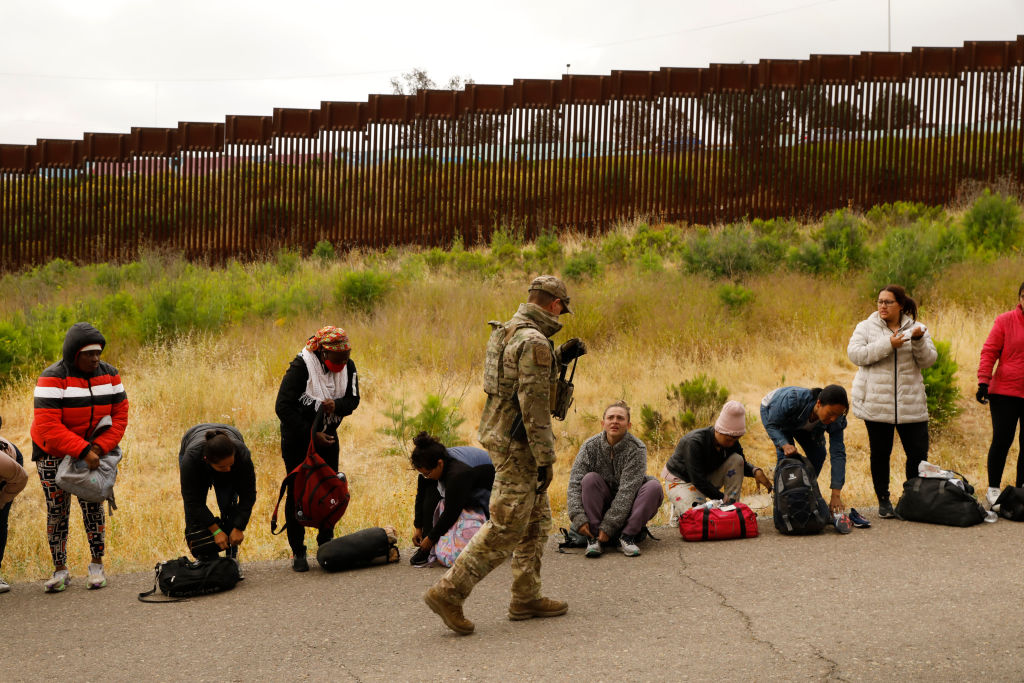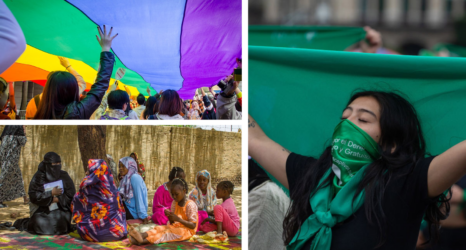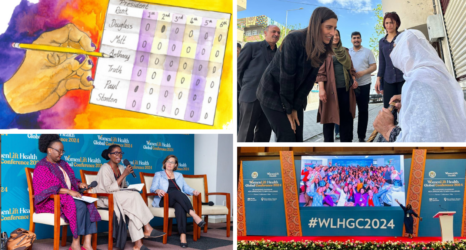Immigrants seeking a better life in the U.S. need compassion, not more restrictive and confusing laws that make access to asylum and other legal pathways difficult.

For months now, the words “we must do something about the border” have been thrown about in the United States—as though the border were a leaky roof or broken window that could be quickly repaired and made new again. Listen closely, however, and it becomes apparent that many politicians mean something different altogether: To them, “doing something about the border” means preventing people from accessing border crossings and preventing them from obtaining asylum or other legal means of entry. The only “fixing” going on is the kind that makes it so people in need can be turned away.
To the thousands of people arriving at the southwest border each day, “doing something about the border” frequently translates into despair and tragedy. Many of the schemes currently being proposed—such as bringing back some form of Title 42 expulsions or gutting the asylum system—will affect real people.
The impact on those real people easily gets lost in budget talks and political squabbling. Understanding who is coming to the border can help us make better decisions about what actually needs to be done to create a functioning migration system.
But painting a picture of who is coming to the U.S. requires some statistical context.
- Of the millions of people crossing or attempting to cross the southwest border into the U.S. each year, most do so without incident. The Department of Homeland Security’s Office of Homeland Statistics reported during fiscal year (FY) 2022, the U.S. granted 97 million non-immigrant admissions, 45 million of which were processed when an immigrant presented at a port of entry (as opposed to having a card that authorizes repeated crossings for work or other pre-approvals).
- Of that number, the San Ysidro, Calif., port of entry processed over 3 million admissions. In that same year, across all U.S. borders, Border Patrol reported 2.2 million encounters with migrants between ports of entry. Most of those encounters resulted in expulsion under Title 42 or removal under the accelerated process of expedited removal.
- Those who were released into the U.S. are often families, unaccompanied children and people who passed a credible fear screening, having been ordered to appear before an immigration judge at a later date. Many join family or friends across the country. Unaccompanied children are housed by the Office of Refugee Resettlement until a parent or other sponsor can take custody of them.
No one just decides to come to the U.S. Sometimes people have been struggling for years, or living in fear, trying to hang on to their lives at home. When they finally leave, it is because they feel they have no choice.
Luis Homes, ProBar
Each person has their own story, but there are some important things to know:
- Border crossers come from all over the world. In FY2022, the top five countries of encounter were Mexico, Guatemala, Cuba, Honduras and Venezuela. In the first months of FY2023, Nicaraguans and Colombians surpassed Hondurans and Guatemalans. By the end of FY 2023, 51 percent of all border encounters involved people from places other than Mexico or northern Central America.
- Conflict, persecution, climate change and poverty continue to drive migrants to the U.S. from countries such as Afghanistan, Ukraine, Russia, India, Peru and China. “Other nationalities,” as a category, makes up a high percentage of those encountered overall, including many people from the African countries of Mauritania, Senegal, Guinea and Angola.
- Since the creation of new parole programs, Venezuelans, Nicaraguans, Haitians and Cubans are less frequently intercepted between ports of entry. Nonetheless, the demand for these programs outstrips the supply, meaning that people from these countries, particularly Venezuelans, continue to risk unlawful border crossings.
- There has been a resurgence of migration from Mexico, fueled by an increase in cartel violence; anecdotally, legal service providers note that they are seeing an increase in LGBTQ individuals fleeing Mexico.
- Sexual violence is one of the greatest dangers women and young girls face along the migration route, according to Doctors Without Borders. And Reuters has reported that rape has become a form of extortion used by criminal gangs and cartels in Mexican border cities where migrants are forced to wait, often for months, before they can get an appointment with U.S. Customs and Border Protection (CBP).
Suffice it to say, the people arriving at our southern border without authorization need help.

According to Luis Homes, a Venezuelan attorney who now works as an accredited representative at ProBar in Harlingen, Texas, many of the people he sees have been living with tragedy for a long time before feeling that they have nowhere to go but the U.S.
“No one just decides to come to the U.S.,” he told me. “Sometimes people have been struggling for years, or living in fear, trying to hang on to their lives at home. When they finally leave, it is because they feel they have no choice. For them, the U.S. is truly a last refuge.”
After fleeing Venezuela more than 13 years ago, Homes understands the forces driving people today and chose to work with recent arrivals seeking relief in immigration court. Over the last five years at ProBar—a project of the American Bar Association—he has worked with unaccompanied children, individuals in detention, members of the LGBTQ community, and immigrants released into the community.
He said every person is different, but they share a strong determination to make the best life possible in the U.S., which “has definitely been impossible in their home countries.”
As an example, he points to education. “I’m always impressed by how many people immediately enroll in school. They want to learn and support themselves.”
Camile Mackler, the head of Immigrant Advocates Response Collaborative (I-ARC)—a nonprofit in New York City that assists asylum seekers, including many who were shipped by bus from Texas—has seen similar determination: “I can’t forget one woman who was living in a shelter who showed up at immigration court carrying her 7-day-old twins. She’d just given birth, had to take the kids on the subway, but there was no way she was going to miss her appointment. When an attorney asked how they could help, she handed her one of the babies to hold.”
Mackler said people she meets want to comply with immigration rules to have the chance to rebuild a normal life in the U.S. More than anything, she said, they love their children, and will do anything to keep them safe.
“One woman from Guatemala told me that she didn’t have much—a little store, some chickens in the yard, her husband and kids, but it was hers. She fled with her youngest kids after the gangs came after her children. She choked up when she told me she was afraid she had lost her husband and her life as she knew it, forever.”
Homes confirmed these are the stories of his clients as well. “These are regular people. They are the ones doing the jobs but they can’t live in their countries anymore. These are young girls who get attacked in their countries or while in Mexico who are now pregnant.”
Mackler said, “They may be policemen, or janitors, or have small shops. They are minding their own business, but then they see something they shouldn’t see and then their lives and their families’ lives are at risk from gangs, or cartels, or corrupt officials.”
What they need more than anything, Homes said, is compassion—not more restrictive and confusing laws that make access to asylum and other legal pathways difficult. That’s why talking about “doing something at the border” is so insidious.
She’d just given birth, had to take the kids on the subway, but there was no way she was going to miss her appointment. When an attorney asked how they could help, she handed her one of the babies to hold.
Camile Mackler, Immigrant Advocates Response Collaborative
Punitive measures that bar people from the U.S. don’t solve or reduce the flow of forced migration—particularly when the U.S. remains a refuge from the crime, violence, corruption, persecution and poverty.
This means that “doing something about the border” can only be genuine when it is really about people—not doing something to them, but for them and with them. As Homes said, we must show compassion to “real people, real families, real problems.”
Compassion, he concluded, “is a deep word that politicians usually do not understand, because they are far away from people and their needs.”
Up next:
U.S. democracy is at a dangerous inflection point—from the demise of abortion rights, to a lack of pay equity and parental leave, to skyrocketing maternal mortality, and attacks on trans health. Left unchecked, these crises will lead to wider gaps in political participation and representation. For 50 years, Ms. has been forging feminist journalism—reporting, rebelling and truth-telling from the front-lines, championing the Equal Rights Amendment, and centering the stories of those most impacted. With all that’s at stake for equality, we are redoubling our commitment for the next 50 years. In turn, we need your help, Support Ms. today with a donation—any amount that is meaningful to you. For as little as $5 each month, you’ll receive the print magazine along with our e-newsletters, action alerts, and invitations to Ms. Studios events and podcasts. We are grateful for your loyalty and ferocity.





